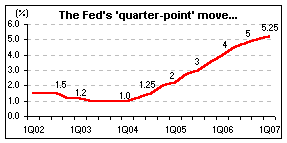The US Fed: Longstanding concerns
 In an almost certain move, the US Federal Reserve in the quarterly FOMC meet once again, did what it has been doing for the past 16 instances, raise the Fed rates by a quarter percentage point (0.25%). Citing the necessity to continue 'policy firming to address inflation risks', the US Fed has raised the benchmark rate to 5.25%, thus dousing hopes of a possible halt in the rate hiking campaign.
In an almost certain move, the US Federal Reserve in the quarterly FOMC meet once again, did what it has been doing for the past 16 instances, raise the Fed rates by a quarter percentage point (0.25%). Citing the necessity to continue 'policy firming to address inflation risks', the US Fed has raised the benchmark rate to 5.25%, thus dousing hopes of a possible halt in the rate hiking campaign.
The Fed's prime concerns herein were a moderation in economic growth partly reflecting in a gradual cooling of the housing market and the lagged effects of increases in interest rates and energy prices. Also, to keep the inflationary pressures in check going forward, the central bank has cited the necessity to keep the liquidity-tightening monetary policy in place. As against popular belief, the Fed, this time, did not mince words to signal that more such measures will be pertinent in the future. It may be recalled that in the earlier meeting the central bank had added a disclaimer "...the extent and timing of any such firming (in the future) will depend, importantly, on the evolution of the economic outlook as implied by incoming information", thus refusing to spill the beans as to the limit upto which the rates could be raised.
The Fed's comments with regard to the rate hike primarily focused on the longstanding concerns about global imbalances. The solution to which were cited as - greater national savings in the US, increased domestic demand in countries with current account surpluses and a greater flexibility of exchange rates. Readers should note that this rate hiking campaign is not only towards paring the pressure arising from rising inflation levels in the US economy, but also to correct (or reduce) the impact of its huge current account imbalance. Should US economic growth moderate as expected, sustaining the global expansion will require a greater reliance by its trading partners (including India) on their own domestic spending as a source of growth.
The possible repercussions… The uninitiated may note that the Fed funds' rate is similar to the reverse repo rate as used by the RBI to manage liquidity in the Indian banking system. This rate is also a benchmark for other broader interest rates (CRR, prime lending rate) in the economy and impacts the cost of funds and lending rates across asset classes.
RBI may follow suit: It may be recalled that taking cues from its global counterparts, the RBI, in an unexpected move raised the repo and reverse repo rates by a quarter percentage point each early this month. RBI's move of raising the interest rates comes as a calculated step towards aligning the domestic economy with the global one. Thus, with the Fed's appetite for rate hike remaining un-satiated, such moves may be further expected from the RBI.
Rupee depreciation: It is also pertinent to have cognizance of the fact that the accelerated rise in the US Fed rate may have an impact on the Indian economy. The depreciating rupee (against the greenback) vindicates the Indian current account imbalance. A further deficit in the same may lead to the rupee losing further ground, thus making our import bill dearer (notwithstanding the impact of rising crude prices).
Equities bear the brunt…In light of the concerns highlighted by us time and again with respect to a faster rise in US interest rates and FII flows reversing their direction towards the 'more attractive' and 'safer' US treasury bills, investors must draw parallel of the same with the recent correction in the stockmarkets.
Conclusion… The writing is clear on the wall. Rate hikes will continue in the global as well as domestic economic scenario. The same will lead to moderation in corporate earnings (due to higher interest burden) and economic growth. While India's consumption story and lesser dependence on exports leaves it well hedged against the global slowdown, the fiscal imbalance lingers as a vital concern. Investors in equities shall, thus, take into consideration that they need to cover their risks adequately before zeroing on to their investment decisions.